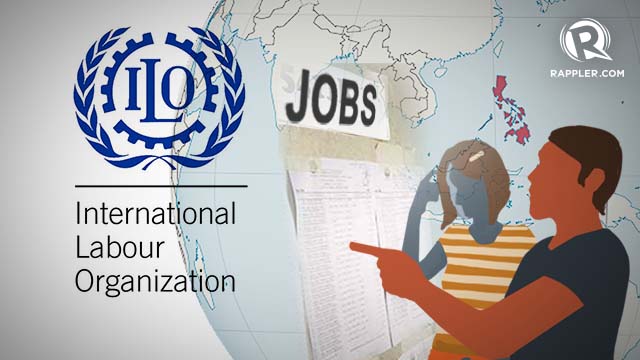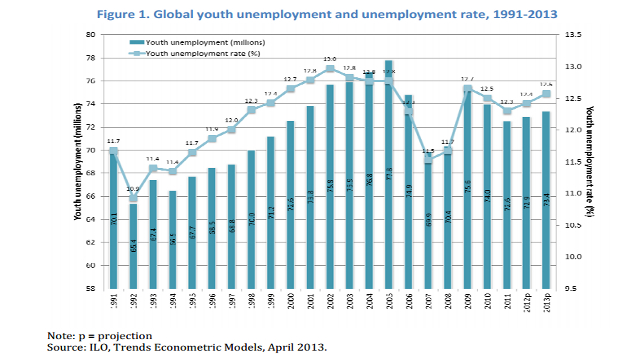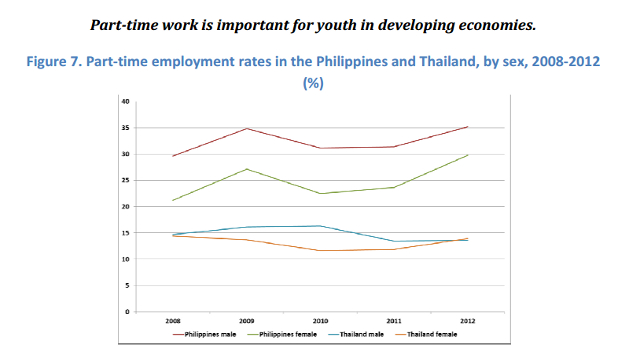SUMMARY
This is AI generated summarization, which may have errors. For context, always refer to the full article.

MANILA, Philippines – Young people across Southeast Asia and the Pacific, including the Philippines, may find it hard to find decent and permanent jobs in the years to come.
A study released by the International Labour Organization (ILO), titled Global Employment Trends for Youth 2013: A generation at risk, said more young people are engaged in informal work primarily due to lack of decent and permanent employment.
ILO noted that the problem of a skills mismatch “makes solutions to the youth employment crisis more difficult to find.”
“The fewer young people in decent and productive work, the less economic growth there is; the less employment growth there is, the fewer the opportunities to get youth into productive work,” Sara Elder said, co-auhtor of the ILO study and research specialist for the ILO Youth Employment Program.

The ILO predicts youth unemployment rate in Southeast Asia and the Pacific to hit 13.3% in 2013 and over 14% in 2017. These numbers are way above the global average of 12.6% in 2013.
Global youth unemployment rate, on the other hand, will likely hit 12.6%, up 0.2% from 12.4% in 2012. This is equivalent to 73.4 million unemployed young people in 2013. The global rate will likely increase to 12.7% and 12.8% in 2014 and 2018, respectively.
Three out of 5 young people, or about 60%, are either unemployed, or trapped in informal, low quality and low paying jobs.
“The waste of economic potential in developing economies is staggering. For an overwhelming number of young people, this means a job does not necessarily equal livelihood,” Elder said.
Philippines: Bright spot
Despite this increasing trend of youth unemployment globally and regionally, the situation is “encouraging” in the Philippines and Indonesia, the two most populous countries in Southeast Asia and the Pacific.
Youth unemployment rate in the Philippines dropped to 16% in the first half of 2012 from 16.6% in the same period in 2011. In Indonesia, youth unemployment rate also dropped significantly to 19.6% in 2012 from 23% in 2011.

Much of the reason for the decline in the Philippines is the increasing engagement of young people in part-time work.
“In the Philippines, youth aged 15-24 saw a decrease in unemployment from 18.6% in April 2008 to 17.3% in April 2009. During that 1-year period, however, the share of youth working part-time (less than 30 hours per week), increased notably from 26.6% to 32%,” the study showed.
The figure further increased to 33.2% in 2012 or an increase of 2.5 million young people engaged in part-time employment.
‘Call-to-action’
The ILO report calls on governments and other institutions to address the skills mismatch issue, among others.
“The report is a call-to-action to equip young people with skills that meet the needs of employers. The private sector, educators and governments will need to collaborate to help young people secure stable employment,” Reeta Roy said, President and CEO of The MasterCard Foundation, a partner of ILO in the making of the report.
The report recommended key policy areas to address the youth employment issue but reiterated that solutions should still be country-specific and should not be taken as a “one-size-fits-all-solution”.
The key policy areas, sourced from the resolution titled The youth employment crisis: A call for action from the International Labor Conference (ILC), include:
- Employment and economic policies to increase aggregate demand and improve access to finance
- Education and training to ease the school-to-work transition and to prevent skills mismatches
- Labor market policies to target employment of disadvantaged youth
- Entrepreneurship and self-employment to assist potential young entrepreneurs
- Labor rights based on international labor standards to ensure that young people receive equal treatment and are afforded rights at work
– Rappler.com
Add a comment
How does this make you feel?
There are no comments yet. Add your comment to start the conversation.